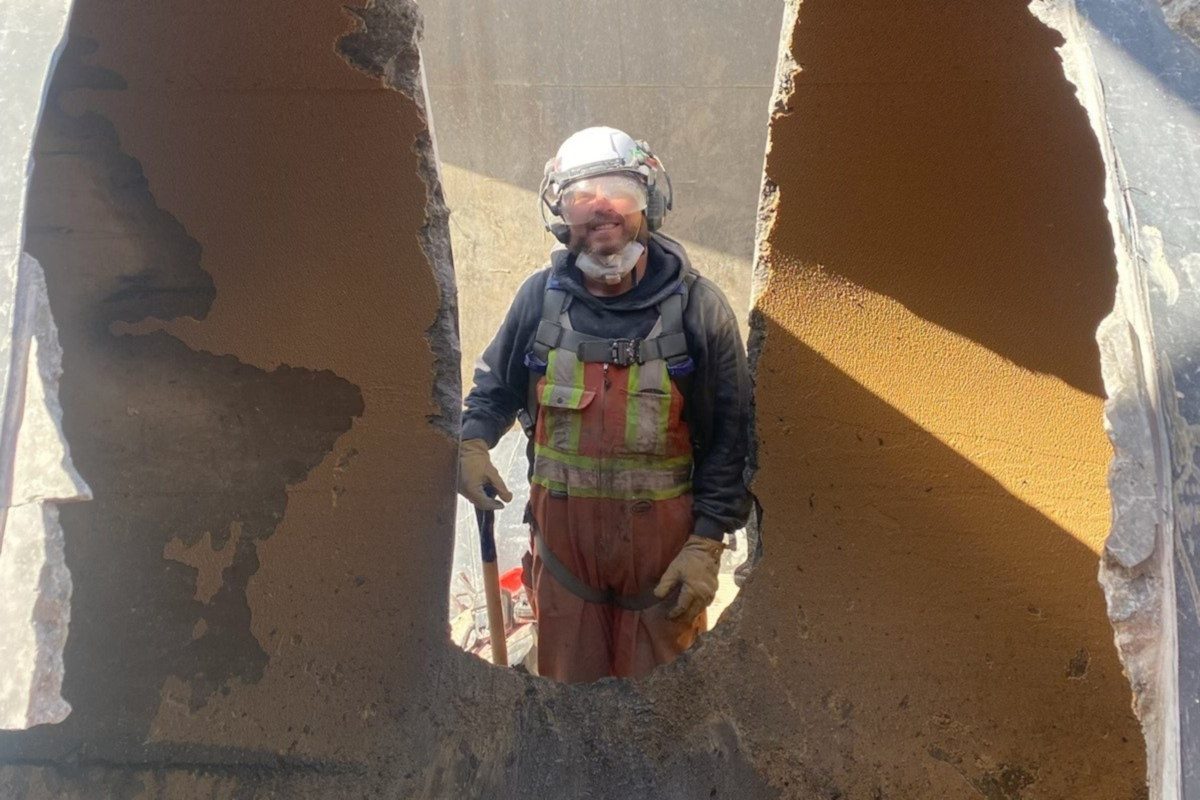
Pipe Ramming Through a Landfill
December 7, 2015
What started out as a relatively straight forward auger bore beneath a BNSF rail line in Denver, rapidly changed into something very different from the time the project was first discussed, to when it was actually constructed.In November 2014, Brannan Construction Co. was asked to install a 36-in. steel casing beneath a BNSF rail line as part of a new 20-in. water line installation. The new 20-in. water line was being installed to replace an existing 20-in. water main that was not steel encased, and would not meet American Railway Engineering and Maintenance-of-Way Association (AREMA) standards for the new light rail lines being constructed.
An initial site visit revealed several high priority utilities in the work area, as well as discovering that the last half of the crossing entered into an old land fill. At this point the decision was made to auger bore just the rail section, and excavate the remainder, even though there were challenges in open cutting through this section — mainly the unknown makeup of the landfill material. This would require an auger bore of about 70 lf, and an open-cut section of between 80 to 100 lf.
Due to the constantly changing nature of design-build projects, it would be March 2015 before Brannan was able to mobilize to the site to start the bore, and then due to several unforeseen utility conflicts onsite, it would be July 2015 before boring operations actually began.
What was originally planned as a 70-lf bore now needed to be 180 lf long, with the last 100 lf being bored through the landfill area and still within proximity to high profile utilities. This was because between March and July, three new light rail tracks, a retaining wall and the relocated BNSF line had been constructed between the tie in points of the new 20-in. water main.
The question now was: Is this installation possible? There was no possibility of open-cut excavation through the landfill — any excavation would have to be done within the 36-in. casing. Would the existing soil conditions and air quality in the casing allow for man entry? Was there a Plan B if the casing could not be installed? The answer to the last question was a resounding no.
Choosing Pipe Ramming
Pipe ramming was chosen as the method most likely to succeed in installing the steel casing through the landfill segment, however, the issue still remained of ensuring the steel casing maintained line and grade throughout the bore so that the existing fiber-optic conduits and existing water line would not be impacted. A decision was made to attempt installing GBM rods to establish a pilot bore. An Akkerman 240 GBM unit was installed in the jacking pit on a Barbco 950 jacking frame and the installation of the GBM pilot rods commenced.
As expected, the first 80 lf or so of pilot rod installation went smoothly, with line and grade being maintained per design. The last 100 lf presented several sections that required some major finessing of the GBM rods, but eventually the GBM rods were advanced to within 15 ft of the end of casing, and within 2 in. of designed line and grade. At this point the GBM rods would not advance any further due to a solid object being encountered that prevented the pilot rods from reaching the exit pit.
It’s often said that it’s better to be lucky than good, and this certainly may be one of those occasions. The GBM rods were stopped 1 ft beyond the newly constructed concrete retaining wall for the new light rails, meaning that the obstruction could be excavated to access the GBM rods.
As the exit pit was excavated to access the pilot tubes, it became apparent that it was indeed luck that the pilot tubes had reached the point that they had. The landfill materials appeared to be mostly construction debris: cinder blocks, concrete pieces complete with post tension cables, wood, steel forms and rock.
The 36-in. steel casing now had a path to follow, but would it be able to withstand being hammered through this material? Would the GBM rods be stiff enough to keep it on line?
To ram the steel casing, an 18-in. Gigant Hammer was brought onsite from TT Technologies, along with a 1,600-cfm air compressor. A GBM rod adaptor was welded onto the 36-in. by 0.625-in. steel casing and all welds on the casing’s were inspected and reinforced as needed. The decision to use the 18-in. hammer instead of a larger 24-in. hammer was made because it was thought that it would be better to stall the 18-in. hammer as it encountered the landfill debris, rather than to risk damaging the steel casing with the more powerful 24-in. hammer. Just like the first 80 lf of GBM rod installation, the first 80 lf of steel casing was installed without any issue. A 5-lf section of the bore at 55 lf was hand tunneled as the steel casing crossed above the 2 Level three fiber-optic conduits.
The new steel casing crossed 18 in. beneath the existing 20-in. water main approximately 150 lf from the jacking pit. This crossing was in the landfill area and the plan was to hand tunnel beneath the water line in case trash was being dragged by the front of the casing which may have impacted the water line, resulting in damage or a failure of the line.
Installation of the steel casing was stopped 10 lf before the existing 20-in. water line crossing. The casing was cleaned out by installing 30-in. augers into the casing, after which air venting of the casing began. After two hours and thorough air quality monitoring, crewmembers entered the casing to inspect the front of the casing and to begin hand tunneling. I’m not sure that Best Practices for Pipe Ramming includes ramming through steel scrap, but that is what was discovered at the front of the casing. Large steel pieces were wrapped around the adaptor, as well as caught on the leading edge of the casing. After removing the scrap steel — with hand tools — and excavating in front of the GBM adaptor, an attempt was made to push the casing with a Barbco 950 auger boring machine.
This was unsuccessful, so the process of ramming the casing 1 to 2 ft/clean out/inspect was repeated until the casing had passed beneath the water line.
The owner of the water line was extremely helpful during this process, and assisted the crew by closing the water main down for periods of time during the crossing. Crossing beneath the water main was completed in three days without impact to the water line.
The remaining 30 lf of pipe ramming was completed in two days, with the steel casing entering the exit pit at the line and grade established by the GBM pilot rods, once again wrapped in scrap steel and post tension cables. Clean out of the casing took an additional two days, as the landfill debris, especially the wood, tended to lock up the 30-in. augers as it was being removed.
The project was ultimately completed on schedule and within budget thanks to the efforts of everyone involved, and a large dose of good old fashioned luck.
David McCallum is a project manager with Brannan Construction Co.






